Positivity Rate of PD-L1 Expression and Its Clinical Significance in Vulvar Cancer: A Systematic Review and Meta-Analysis
Abstract
1. Introduction
2. Materials and Methods
2.1. The Search Strategy
2.2. Inclusion and Exclusion Criteria
2.3. Study Selection, Data Extraction, and Risk of Bias
2.4. Statistical Analysis
3. Results
3.1. A Description of the Included Studies
3.2. PD-L1 Expression in VSCCs
3.3. PD-L1 Expression and VSCC Prognosis
4. Discussion
5. Conclusions
Supplementary Materials
Author Contributions
Funding
Informed Consent Statement
Data Availability Statement
Conflicts of Interest
Abbreviations
| CI | Confidence Interval |
| CPS | Combined Positive Score |
| CSS | Cancer-Specific Survival |
| DFS | Disease-Free Survival |
| HR | Hazard Ratio |
| HPV | Human Papillomavirus |
| IC | Immune Cells |
| JAK2/STAT1 | Janus Kinase 2/Signal Transducer and Activator of Transcription 1 |
| NOS | Newcastle–Ottawa Scale |
| OR | Odds Ratio |
| OS | Overall Survival |
| PD-1 | Programmed Cell Death Protein 1 |
| PD-L1 | Programmed Death Ligand 1 |
| PI3K/Akt | Phosphoinositide 3-Kinase/Protein Kinase B |
| PRISMA | Preferred Reporting Items for Systematic Reviews and Meta-Analyses |
| PROSPERO | International Prospective Register of Systematic Reviews |
| PFS | Progression-Free Survival |
| qPCR | Quantitative Polymerase Chain Reaction |
| Ras/MEK/ERK | Rat Sarcoma/Mitogen-Activated Protein Kinase Kinase/Extracellular Signal-Regulated Kinase |
| RFS | Recurrence-Free Survival |
| RR | Relative Risk |
| TC | Tumor Cells |
| TCS | Tumor Cell Score |
| TPS | Tumor Proportion Score |
| VC | Vulvar Cancer |
| VSCC | Vulvar Squamous Cell Carcinoma |
| WHO | World Health Organization |
References
- Thangarajah, F.; Morgenstern, B.; Pahmeyer, C.; Schiffmann, L.M.; Puppe, J.; Mallmann, P.; Hamacher, S.; Buettner, R.; Alidousty, C.; Holz, B.; et al. Clinical Impact of PD-L1 and PD-1 Expression in Squamous Cell Cancer of the Vulva. J. Cancer Res. Clin. Oncol. 2019, 145, 1651–1660. [Google Scholar] [CrossRef] [PubMed]
- Dellinger, T.H.; Hakim, A.A.; Lee, S.J.; Wakabayashi, M.T.; Morgan, R.J.; Han, E.S. Surgical Management of Vulvar Cancer. J. Natl. Compr. Canc. Netw. 2017, 15, 121–128. [Google Scholar] [CrossRef]
- Bray, F.; Laversanne, M.; Sung, H.; Ferlay, J.; Siegel, R.L.; Soerjomataram, I.; Jemal, A. Global Cancer Statistics 2022: GLOBOCAN Estimates of Incidence and Mortality Worldwide for 36 Cancers in 185 Countries. CA Cancer J Clin 2024, 74, 229–263. [Google Scholar] [CrossRef]
- Koncar, R.F.; Feldman, R.; Bahassi, E.M.; Hashemi Sadraei, N. Comparative Molecular Profiling of HPV-Induced Squamous Cell Carcinomas. Cancer Med. 2017, 6, 1673–1685. [Google Scholar] [CrossRef] [PubMed]
- Czogalla, B.; Pham, D.; Trillsch, F.; Rottmann, M.; Gallwas, J.; Burges, A.; Mahner, S.; Kirchner, T.; Jeschke, U.; Mayr, D.; et al. PD-L1 Expression and Survival in P16-Negative and -Positive Squamous Cell Carcinomas of the Vulva. J. Cancer Res. Clin. Oncol. 2020, 146, 569–577. [Google Scholar] [CrossRef]
- Kortekaas, K.E.; Santegoets, S.J.; Tas, L.; Ehsan, I.; Charoentong, P.; Van Doorn, H.C.; Van Poelgeest, M.I.E.; Mustafa, D.A.M.; Van Der Burg, S.H. Primary Vulvar Squamous Cell Carcinomas with High T Cell Infiltration and Active Immune Signaling Are Potential Candidates for Neoadjuvant PD-1/PD-L1 Immunotherapy. J. Immunother. Cancer 2021, 9, e003671. [Google Scholar] [CrossRef]
- Lérias, S.; Esteves, S.; Silva, F.; Cunha, M.; Cochicho, D.; Martins, L.; Félix, A. CD274 (PD-L1), CDKN2A (P16), TP53, and EGFR Immunohistochemical Profile in Primary, Recurrent and Metastatic Vulvar Cancer. Mod. Pathol. 2020, 33, 893–904. [Google Scholar] [CrossRef] [PubMed]
- Merlo, S. Modern Treatment of Vulvar Cancer. Radiol. Oncol. 2020, 54, 371–376. [Google Scholar] [CrossRef]
- Hecking, T.; Thiesler, T.; Schiller, C.; Lunkenheimer, J.-M.M.; Ayub, T.H.; Rohr, A.; Condic, M.; Keyver-Paik, M.-D.D.; Fimmers, R.; Kirfel, J.; et al. Tumoral PD-L1 Expression Defines a Subgroup of Poor-Prognosis Vulvar Carcinomas with Non-Viral Etiology. Oncotarget 2017, 8, 92890–92903. [Google Scholar] [CrossRef]
- Sznurkowski, J.J.; Zawrocki, A.; Sznurkowska, K.; Peksa, R.; Biernat, W.; Żawrocki, A.; Sznurkowska, K.; Pęksa, R.; Biernat, W. PD-L1 Expression on Immune Cells Is a Favorable Prognostic Factor for Vulvar Squamous Cell Carcinoma Patients. Oncotarget 2017, 8, 89903–89912. [Google Scholar] [CrossRef]
- How, J.A.; Jazaeri, A.A.; Soliman, P.T.; Fleming, N.D.; Gong, J.; Piha-Paul, S.A.; Janku, F.; Stephen, B.; Naing, A. Pembrolizumab in Vaginal and Vulvar Squamous Cell Carcinoma: A Case Series from a Phase II Basket Trial. Sci. Rep. 2021, 11, 1–7. [Google Scholar] [CrossRef] [PubMed]
- Wendel Naumann, R.; Hollebecque, A.; Meyer, T.; Devlin, M.J.; Oaknin, A.; Kerger, J.; López-Picazo, J.M.; Machiels, J.P.; Delord, J.P.; Evans, T.R.J.; et al. Safety and Efficacy of Nivolumab Monotherapy in Recurrent or Metastatic Cervical, Vaginal, or Vulvar Carcinoma: Results from the Phase I/II CheckMate 358 Trial. J. Clin. Oncol. 2019, 37, 2825–2834. [Google Scholar] [CrossRef]
- Shields, L.B.E.E.; Gordinier, M.E. Pembrolizumab in Recurrent Squamous Cell Carcinoma of the Vulva: Case Report and Review of the Literature. Gynecol. Obstet. Invest. 2019, 84, 94–98. [Google Scholar] [CrossRef]
- Wang, S.; Yuan, B.; Wang, Y.; Li, M.; Liu, X.; Cao, J.; Li, C.; Hu, J. Clinicopathological and Prognostic Significance of PD-L1 Expression in Colorectal Cancer: A Meta-Analysis. Int. J. Colorectal Dis. 2021, 36, 117–130. [Google Scholar] [CrossRef] [PubMed]
- Acheampong, E.; Abed, A.; Morici, M.; Bowyer, S.; Amanuel, B.; Lin, W.; Millward, M.; Gray, E.S. Tumour PD-L1 Expression in Small-Cell Lung Cancer: A Systematic Review and Meta-Analysis. Cells 2020, 9, 2393. [Google Scholar] [CrossRef]
- Adiputra, P.A.T.; Sudarsa, I.W.; Wihandani, D.M.; Saputra, I.P.G.S.; Wiranata, S.; Supadmanaba, I.G.P. Analysis of PD-L1 Expression in Breast Cancer: A Systematic Review and Meta-Analysis in Asian Population. Asian Pac. J. Cancer Prev. 2023, 24, 1453–1462. [Google Scholar] [CrossRef]
- Steiniche, T.; Ladekarl, M.; Georgsen, J.B.; Andreasen, S.; Busch-Sørensen, M.; Zhou, W.; Marton, M.J.; Pruitt, S.K.; Jin, F.; Liaw, K.L. Association of Programmed Death Ligand 1 Expression with Prognosis among Patients with Ten Uncommon Advanced Cancers. Future Sci. OA 2020, 6, FSO616. [Google Scholar] [CrossRef]
- Han, Y.; Liu, D.; Li, L. PD-1/PD-L1 Pathway: Current Researches in Cancer. Am. J. Cancer Res. 2020, 10, 727–742. [Google Scholar] [PubMed]
- Chinn, Z.; Stoler, M.H.; Mills, A.M. PD-L1 and IDO Expression in Cervical and Vulvar Invasive and Intraepithelial Squamous Neoplasias: Implications for Combination Immunotherapy. Histopathology 2019, 74, 256–268. [Google Scholar] [CrossRef]
- Contos, G.; Baca, Y.; Xiu, J.; Brown, J.; Holloway, R.; Korn, W.M.; Herzog, T.J.; Jones, N.; Winer, I. Assessment of Immune Biomarkers and Establishing a Triple Negative Phenotype in Gynecologic Cancers. Gynecol. Oncol. 2021, 163, 312–319. [Google Scholar] [CrossRef]
- Kim, M.; Chang, C.S.; Choi, M.C.; Lee, J.W.; Park, H.; Joo, W.D. Rechallenge with Anti-PD-1 Inhibitors in Patients with Recurrent Gynecologic Malignancies. Yonsei Med. J. 2023, 64, 587–592. [Google Scholar] [CrossRef]
- Scheel, A.H.; Dietel, M.; Heukamp, L.C.; Jöhrens, K.; Kirchner, T.; Reu, S.; Rüschoff, J.; Schildhaus, H.U.; Schirmacher, P.; Tiemann, M.; et al. Harmonized PD-L1 Immunohistochemistry for Pulmonary Squamous-Cell and Adenocarcinomas. Mod. Pathol. 2016, 29, 1165–1172. [Google Scholar] [CrossRef]
- Agilent Technologies. PD-L1 IHC 22C3 PharmDx Interpretation Manual-Urothelial Carcinoma FDA-Approved for in Vitro Diagnostic Use; Agilent: Santa Clara, CA, USA, 2021. [Google Scholar]
- Kolitz, E.; Lucas, E.; Hosler, G.A.; Kim, J.; Hammer, S.; Lewis, C.; Xu, L.; Day, A.T.; Mauskar, M.; Lea, J.S.; et al. Human Papillomavirus–Positive and –Negative Vulvar Squamous Cell Carcinoma Are Biologically but Not Clinically Distinct. J. Investig. Dermatol. 2022, 142, 1280–1290.e7. [Google Scholar] [CrossRef] [PubMed]
- Bardhan, K.; Anagnostou, T.; Boussiotis, V.A. The PD1: PD-L1/2 Pathway from Discovery to Clinical Implementation. Front. Immunol. 2016, 7, 550. [Google Scholar] [CrossRef] [PubMed]
- Xing, D.; Liu, Y.; Park, H.J.; Baek, I.; Tran, H.; Cheang, G.; Novo, J.; Dillon, J.; Matoso, A.; Farmer, E.; et al. Recurrent Genetic Alterations and Biomarker Expression in Primary and Metastatic Squamous Cell Carcinomas of the Vulva. Hum. Pathol. 2019, 92, 67–80. [Google Scholar] [CrossRef]
- Cereceda, K.; Bravo, N.; Jorquera, R.; González-Stegmaier, R.; Villarroel-Espíndola, F. Simultaneous and Spatially-Resolved Analysis of T-Lymphocytes, Macrophages and PD-L1 Immune Checkpoint in Rare Cancers. Cancers 2022, 14, 2815. [Google Scholar] [CrossRef] [PubMed]
- Marinelli, O.; Annibali, D.; Aguzzi, C.; Tuyaerts, S.; Amant, F.; Morelli, M.B.; Santoni, G.; Amantini, C.; Maggi, F.; Nabissi, M. The Controversial Role of PD-1 and Its Ligands in Gynecological Malignancies. Front. Oncol. 2019, 9, 1–11. [Google Scholar] [CrossRef]
- Necchi, A.; Spiess, P.E.; Bandini, M.; Basile, G.; Grivas, P.; Bratslavsky, G.; Jacob, J.; Danziger, N.; Lin, D.; Decker, B.; et al. Advanced Squamous Cell Carcinomas of the Pelvic and Perineal Region: A Comprehensive Genomic Profiling Study. Oncologist 2022, 27, 1016–1024. [Google Scholar] [CrossRef]
- Zerdes, I.; Matikas, A.; Bergh, J.; Rassidakis, G.Z.; Foukakis, T. Genetic, Transcriptional and Post-Translational Regulation of the Programmed Death Protein Ligand 1 in Cancer: Biology and Clinical Correlations. Oncogene 2018, 37, 4639–4661. [Google Scholar] [CrossRef]
- Moher, D.; Liberati, A.; Tetzlaff, J.; Altman, D.G.; Antes, G.; Atkins, D.; Barbour, V.; Barrowman, N.; Berlin, J.A.; Clark, J.; et al. Preferred Reporting Items for Systematic Reviews and Meta-Analyses: The PRISMA Statement. PLoS Med. 2009, 6, e1000097. [Google Scholar] [CrossRef]
- Wells, G.A.; Shea, B.; O’Connell, D.; Peterson, J.; Welch, V.; Losos, M.; Tugwell, P. The Newcastle-Ottawa Scale (NOS) for Assessing the Quality if Nonrandomized Studies in Meta-Analyses. Available online: http://www.ohri.ca/programs/clinical_epidemiology/oxford.htm (accessed on 20 March 2025).
- Cocks, M.; Chaux, A.; Jenson, E.G.; Miller, J.A.; Rodriguez Pena, M.D.C.; Tregnago, A.C.; Taheri, D.; Eich, M.L.; Sharma, R.; Vang, R.; et al. Immune Checkpoint Status and Tumor Microenvironment in Vulvar Squamous Cell Carcinoma. Virchows Archiv. 2020, 477, 93–102. [Google Scholar] [CrossRef] [PubMed]
- Howitt, B.E.; Sun, H.H.; Roemer, M.G.M.; Kelley, A.; Chapuy, B.; Aviki, E.; Pak, C.; Connelly, C.; Gjini, E.; Shi, Y.; et al. Genetic Basis for PD-L1 Expression in Squamous Cell Carcinomas of the Cervix and Vulva. JAMA Oncol. 2016, 2, 518–522. [Google Scholar] [CrossRef]
- Palisoul, M.L.; Mullen, M.M.; Feldman, R.; Thaker, P.H. Identification of Molecular Targets in Vulvar Cancers. Gynecol. Oncol. 2017, 146, 305–313. [Google Scholar] [CrossRef] [PubMed]
- Choschzick, M.; Gut, A.; Fink, D. PD-L1 Receptor Expression in Vulvar Carcinomas Is HPV-Independent. Virchows Archiv. 2018, 473, 513–516. [Google Scholar] [CrossRef] [PubMed]
- Ott, P.A.; Bang, Y.-J.J.; Piha-Paul, S.A.; Razak, A.R.A.; Bennouna, J.; Soria, J.-C.S.; Hope, R.S.; Cohen, R.B.; O-Neil, B.H.; Mehnert, J.M.; et al. T-Cell–Inflamed Gene-Expression Profile, Programmed Death Ligand 1 Expression, and Tumor Mutational Burden Predict Efficacy in Patients Treated with Pembrolizumab across 20 Cancers: KEYNOTE-028. J. Clin. Oncol. 2019, 37, 318–327. [Google Scholar] [CrossRef]
- Curley, J.; Conaway, M.R.; Chinn, Z.; Duska, L.; Stoler, M.; Mills, A.M. Looking Past PD-L1: Expression of Immune Checkpoint TIM-3 and Its Ligand Galectin-9 in Cervical and Vulvar Squamous Neoplasia. Mod. Pathol. 2020, 33, 1182–1192. [Google Scholar] [CrossRef]
- Dibbern, M.E.; Bullock, T.N.; Jenkins, T.M.; Duska, L.R.; Stoler, M.H.; Mills, A.M. Loss of MHC Class i Expression in HPV-Associated Cervical and Vulvar Neoplasia: A Potential Mechanism of Resistance to Checkpoint Inhibition. Am. J. Surg. Pathol. 2020, 44, 1184–1191. [Google Scholar] [CrossRef]
- Williams, E.A.; Werth, A.J.; Sharaf, R.; Montesion, M.; Sokol, E.S.; Pavlick, D.C.; McLaughlin-Drubin, M.; Erlich, R.; Toma, H.; Williams, K.J.; et al. Vulvar Squamous Cell Carcinoma: Comprehensive Genomic Profiling of HPV+ Versus HPV—Forms Reveals Distinct Sets of Potentially Actionable Molecular Targets. JCO Precis. Oncol. 2020, 4, 647–661. [Google Scholar] [CrossRef]
- Garganese, G.; Inzani, F.; Fragomeni, S.M.; Mantovani, G.; Della Corte, L.; Piermattei, A.; Santoro, A.; Angelico, G.; Giacò, L.; Corrado, G.; et al. The Vulvar Immunohistochemical Panel (Vip) Project: Molecular Profiles of Vulvar Squamous Cell Carcinoma. Cancers 2021, 13, 6373. [Google Scholar] [CrossRef]
- Shapira-Frommer, R.; Mileshkin, L.; Manzyuk, L.; Penel, N.; Burge, M.; Piha-Paul, S.A.; Girda, E.; Lopez Martin, J.A.; van Dongen, M.G.J.; Italiano, A.; et al. Efficacy and Safety of Pembrolizumab for Patients with Previously Treated Advanced Vulvar Squamous Cell Carcinoma: Results from the Phase 2 KEYNOTE-158 Study. Gynecol. Oncol. 2022, 166, 211–218. [Google Scholar] [CrossRef]
- Corey, L.; Wallbillich, J.J.; Wu, S.; Farrell, A.; Hodges, K.; Xiu, J.; Nabhan, C.; Guastella, A.; Kheil, M.; Gogoi, R.; et al. The Genomic Landscape of Vulvar Squamous Cell Carcinoma. Int. J. Gynecol. Pathol. 2023, 42, 515–522. [Google Scholar] [CrossRef] [PubMed]
- Zhang, T.; Zhu, Y.; Luo, J.; Li, J.; Niu, S.; Chen, H.; Zhou, F. An Integrated Model for Prognosis in Vulvar Squamous Cell Carcinoma. BMC Cancer 2023, 23, 534. [Google Scholar] [CrossRef] [PubMed]
- Bui, C.M.; Medeiros, F.; Azimpouran, M.; Venturina, M.; Balzer, B. PD-L1 Expression in HPV-Associated Versus HPV-Independent Invasive Vulvar Squamous Cell Carcinoma. Int. J. Gynecol. Pathol. 2024, 43, 405–413. [Google Scholar] [CrossRef] [PubMed]
- Gordinier, M.E.; Schau, G.F.; Pollock, S.B.; Shields, L.B.E.; Talwalkar, S. Genomic Characterization of Vulvar Squamous Cell Carcinoma Reveals Differential Gene Expression Based on Clinical Outcome. Gynecol. Oncol. 2024, 180, 111–117. [Google Scholar] [CrossRef]
- Mamat @ Yusof, M.N.; Chew, K.T.; Kampan, N.; Nor, N.H.; Md Zin, R.R.; Tan, G.C.; Shafiee, M.N. PD-L1 Expression in Endometrial Cancer and Its Association with Clinicopathological Features: A Systematic Review and Meta-Analysis. Cancers 2022, 14, 3911. [Google Scholar] [CrossRef]
- Boman, C.; Zerdes, I.; Mårtensson, K.; Bergh, J.; Foukakis, T.; Valachis, A.; Matikas, A. Discordance of PD-L1 Status between Primary and Metastatic Breast Cancer: A Systematic Review and Meta-Analysis. Cancer Treat. Rev. 2021, 99, 102257. [Google Scholar] [CrossRef]
- Fakhri, G.; Akel, R.; Khalifeh, I.; Chami, H.; Hajj Ali, A.; Al Assaad, M.; Atwi, H.; Kadara, H.; Tfayli, A. Prevalence of Programmed Death Ligand-1 in Patients Diagnosed with Non-Small Cell Lung Cancer in Lebanon. SAGE Open Med. 2021, 9, 20503121211043709. [Google Scholar] [CrossRef]
- Fu, H.; Fu, Z.; Mao, M.; Si, L.; Bai, J.; Wang, Q.; Guo, R. Prevalence and Prognostic Role of PD-L1 in Patients with Gynecological Cancers: A Systematic Review and Meta-Analysis. Crit. Rev. Oncol. Hematol. 2023, 189, 104084. [Google Scholar] [CrossRef]
- Li, J.-B.; Lai, M.-Y.; Lin, Z.-C.; Guan, W.-L.; Sun, Y.-T.; Yang, J.; Wang, W.-X.; Yang, Z.-R.; Qiu, M.-Z. The Optimal Threshold of PD-L1 Combined Positive Score to Predict the Benefit of PD-1 Antibody plus Chemotherapy for Patients with HER2-Negative Gastric Adenocarcinoma: A Meta-Analysis. Cancer Immunol. Immunother. 2024, 73, 132. [Google Scholar] [CrossRef]
- Khan, M.; Du, K.; Ai, M.; Wang, B.; Lin, J.; Ren, A.; Chen, C.; Huang, Z.; Qiu, W.; Yuan, Y.; et al. PD-L1 Expression as Biomarker of Efficacy of PD-1/PD-L1 Checkpoint Inhibitors in Metastatic Triple Negative Breast Cancer: A Systematic Review and Meta-Analysis. Front. Immunol. 2023, 14, 1060308. [Google Scholar] [CrossRef]
- Mantovani, G.; Fragomeni, S.M.; Inzani, F.; Fagotti, A.; Della Corte, L.; Gentileschi, S.; Tagliaferri, L.; Zannoni, G.F.; Scambia, G.; Garganese, G. Molecular Pathways in Vulvar Squamous Cell Carcinoma: Implications for Target Therapeutic Strategies. J. Cancer Res. Clin. Oncol. 2020, 146, 1647–1658. [Google Scholar] [CrossRef]
- Lei, Q.; Wang, D.; Sun, K.; Wang, L.; Zhang, Y. Resistance Mechanisms of Anti-PD1/PDL1 Therapy in Solid Tumors. Front. Cell Dev. Biol. 2020, 8, 672. [Google Scholar] [CrossRef]
- Qiu, L.; Zheng, H.; Zhao, X. The Prognostic and Clinicopathological Significance of PD-L1 Expression in Patients with Diffuse Large B-Cell Lymphoma: A Meta-Analysis. BMC Cancer 2019, 19, 273. [Google Scholar] [CrossRef] [PubMed]
- Wu, P.; Wu, D.; Li, L.; Chai, Y.; Huang, J. PD-L1 and Survival in Solid Tumors: A Meta-Analysis. PLoS ONE 2015, 10, 131403. [Google Scholar] [CrossRef]
- Mocan, L.P.; Craciun, R.; Grapa, C.; Melincovici, C.S.; Rusu, I.; Al Hajjar, N.; Sparchez, Z.; Leucuta, D.; Ilies, M.; Sparchez, M.; et al. PD-L1 Expression on Immune Cells, but Not on Tumor Cells, Is a Favorable Prognostic Factor for Patients with Intrahepatic Cholangiocarcinoma. Cancer Immunol. Immunother. 2023, 72, 1003–1014. [Google Scholar] [CrossRef] [PubMed]
- Blažek, T.; Petráš, M.; Knybel, L.; Cvek, J.; Soumarová, R. Programmed Cell Death Ligand 1 Expression on Immune Cells and Survival in Patients with Nonmetastatic Head and Neck Cancer: A Systematic Review and Meta-Analysis. JAMA Netw. Open 2023, 6, E236324. [Google Scholar] [CrossRef]
- Badve, S.S.; Penault-Llorca, F.; Reis-Filho, J.S.; Deurloo, R.; Siziopikou, K.P.; D’Arrigo, C.; Viale, G. Determining PD-L1 Status in Patients with Triple-Negative Breast Cancer: Lessons Learned from IMpassion130. J. Natl. Cancer Inst. 2022, 114, 664–675. [Google Scholar] [CrossRef]
- Noske, A.; Wagner, D.C.; Schwamborn, K.; Foersch, S.; Steiger, K.; Kiechle, M.; Oettler, D.; Karapetyan, S.; Hapfelmeier, A.; Roth, W.; et al. Interassay and Interobserver Comparability Study of Four Programmed Death-Ligand 1 (PD-L1) Immunohistochemistry Assays in Triple-Negative Breast Cancer. Breast 2021, 60, 238–244. [Google Scholar] [CrossRef]
- Mercier, A.; Conan-Charlet, V.; Quintin-Roué, I.; Doucet, L.; Marcorelles, P.; Uguen, A. Reproducibility in PD-L1 Immunohistochemistry Quantification through the Tumor Proportion Score and the Combined Positive Score: Could Dual Immunostaining Help Pathologists? Cancers 2023, 15, 2768. [Google Scholar] [CrossRef]
- Liu, C.; Fan, L.; Wu, Q.; Shi, Y.; Sun, X. Prognostic Significance of PD-L1 Expression in Pancreatic Cancer: Evidence from an Updated Meta-Analysis. Pol. J. Pathol. 2023, 74, 151–160. [Google Scholar] [CrossRef]
- Hu, T.; Wan, X.; Wu, H.; Cheng, X.; Xu, S. Predictive Values of PD-L1 Expression for Survival Outcomes in Patients with Cervical Cancer: A Systematic Review and Meta-Analysis. Ginekol. Pol. 2022, 93, 767–774. [Google Scholar] [CrossRef] [PubMed]
- Zhang, Y.; Tian, J.; Qu, C.; Tang, Z.; Wang, Y.; Li, K.; Yang, Y.; Liu, S. Prognostic Value of Programmed Cell Death Ligand-1 Expression in Breast Cancer: A Meta-Analysis. Medicine 2020, 99, E23359. [Google Scholar] [CrossRef] [PubMed]
- Silva, F.F.V.E.; Padín-Iruegas, M.E.; Caponio, V.C.A.; Lorenzo-Pouso, A.I.; Saavedra-Nieves, P.; Chamorro-Petronacci, C.M.; Suaréz-Peñaranda, J.; Pérez-Sayáns, M. Caspase 3 and Cleaved Caspase 3 Expression in Tumorogenesis and Its Correlations with Prognosis in Head and Neck Cancer: A Systematic Review and Meta-Analysis. Int. J. Mol. Sci. 2022, 23, 11937. [Google Scholar] [CrossRef]
- Qiao, W.; Wang, W.; Liu, H.; Guo, W.; Li, P.; Deng, M. Prognostic and Clinical Significance of Focal Adhesion Kinase Expression in Breast Cancer: A Systematic Review and Meta-Analysis. Transl. Oncol. 2020, 13, 100835. [Google Scholar] [CrossRef] [PubMed]
- Schwab, R.; Schiestl, L.J.; Cascant Ortolano, L.; Klecker, P.H.; Schmidt, M.M.W.; Almstedt, K.; Heimes, A.-S.S.; Brenner, W.; Stewen, K.; Schmidt, M.M.W.; et al. Efficacy of Pembrolizumab in Advanced Cancer of the Vulva: A Systematic Review and Single-Arm Meta-Analysis. Front. Oncol. 2024, 14, 1352975. [Google Scholar] [CrossRef]
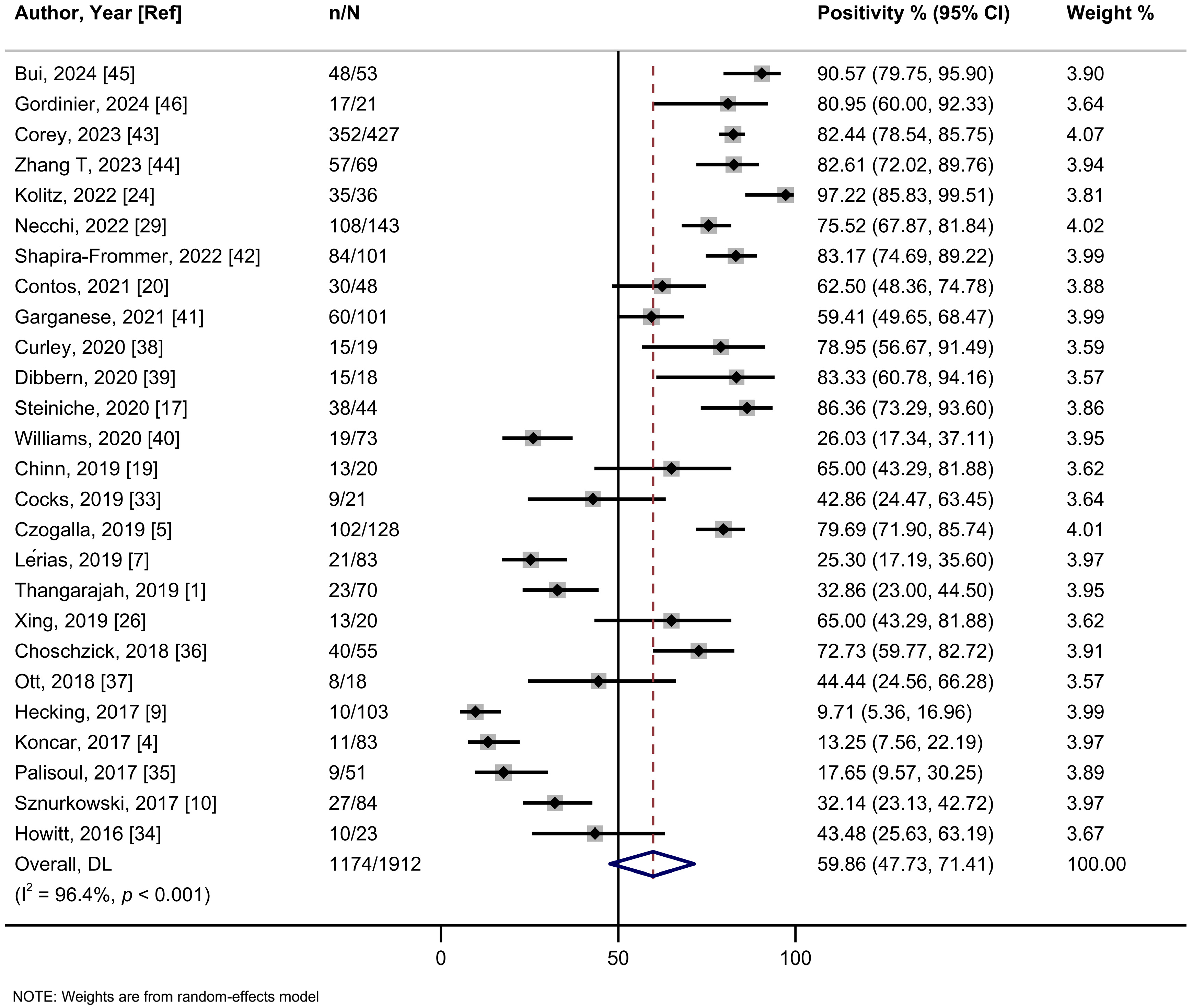
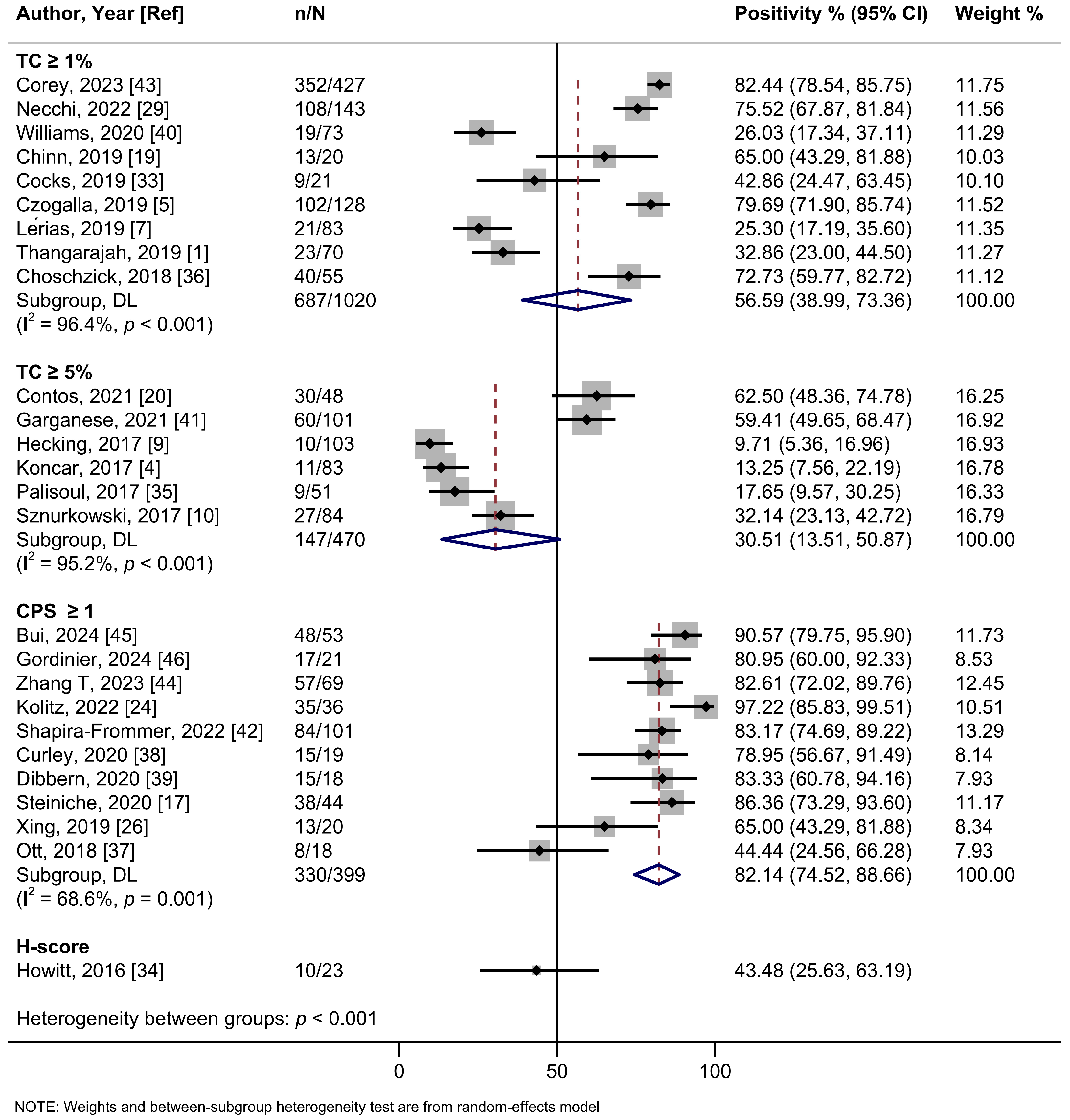
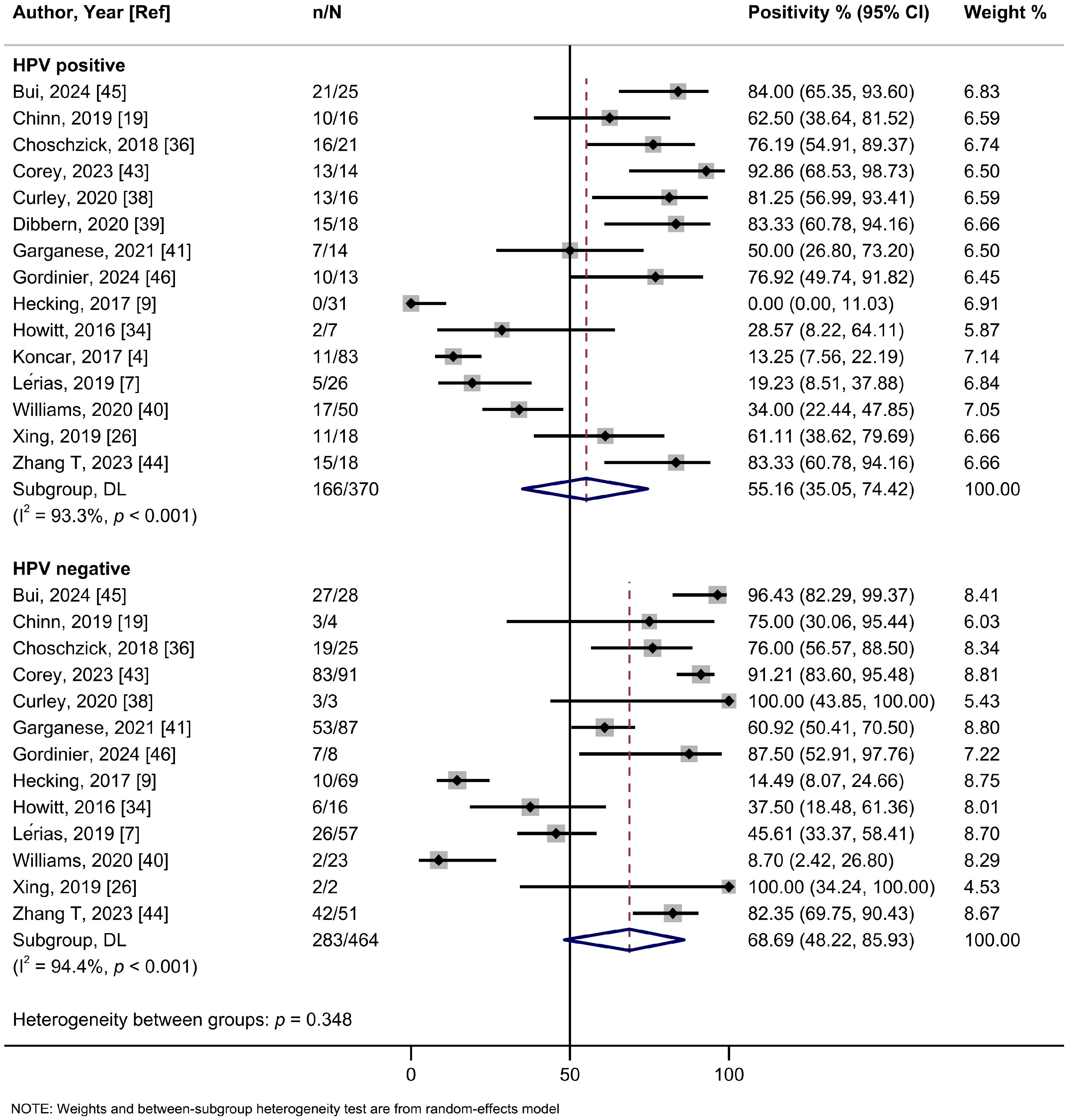
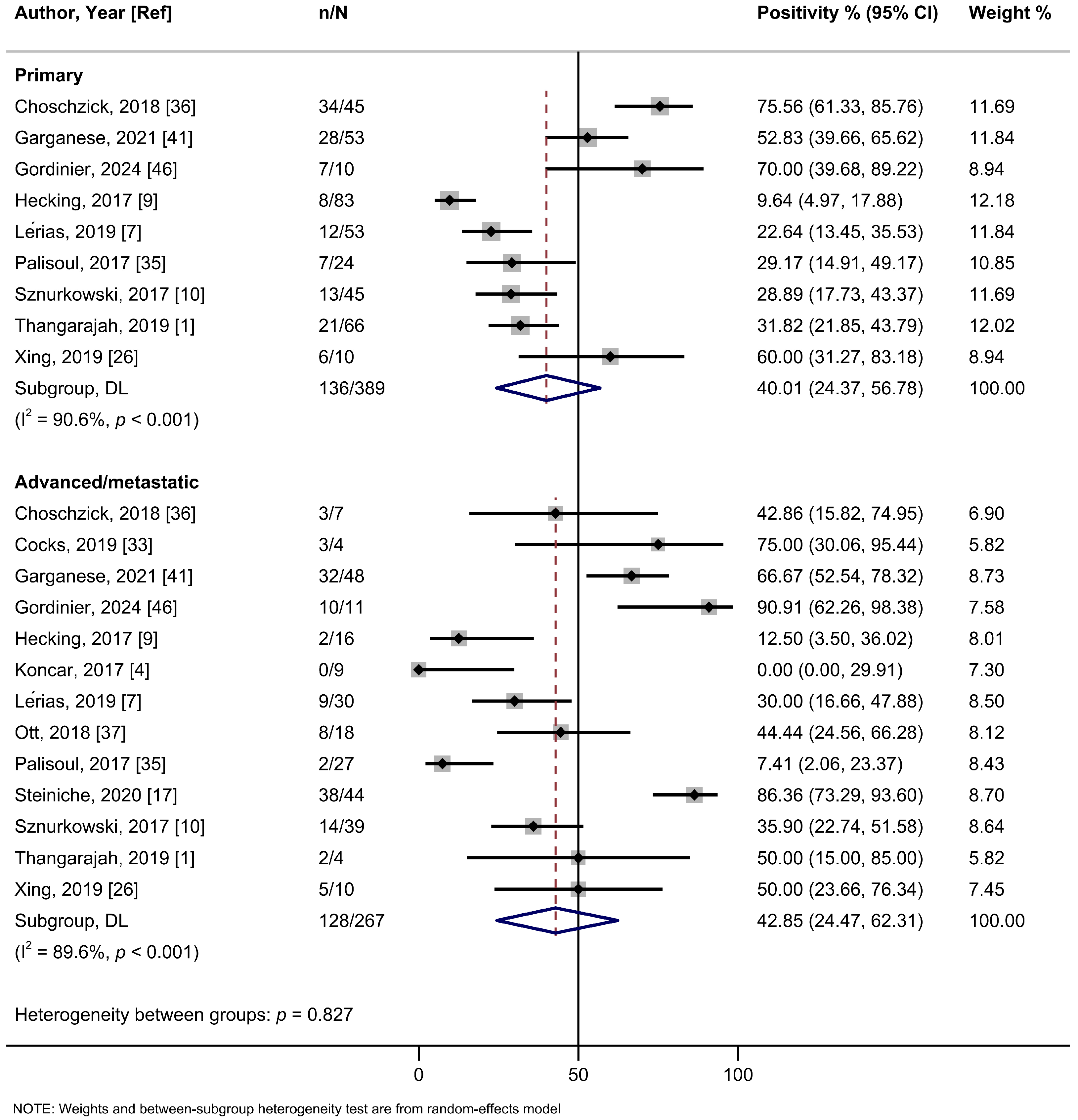
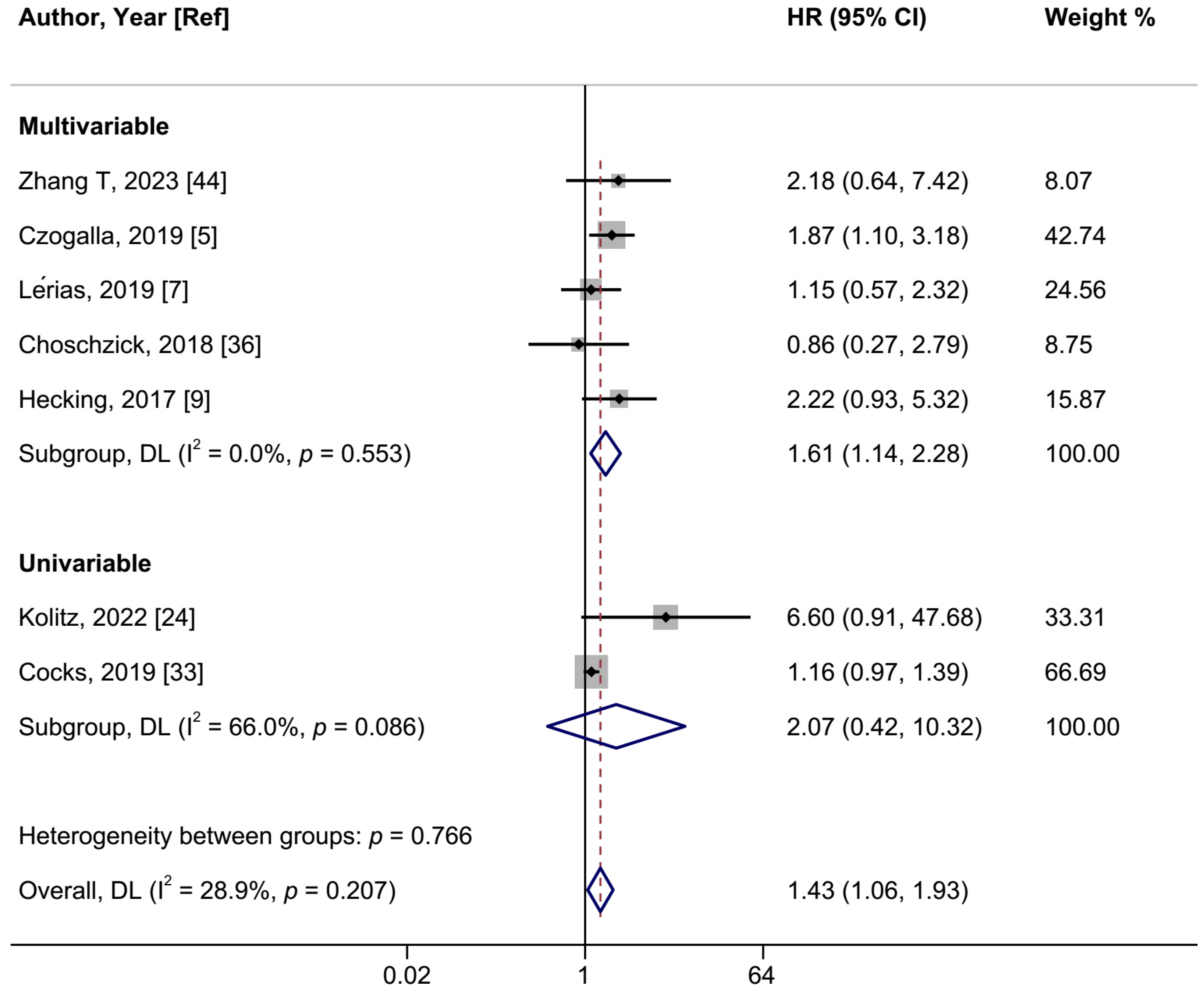
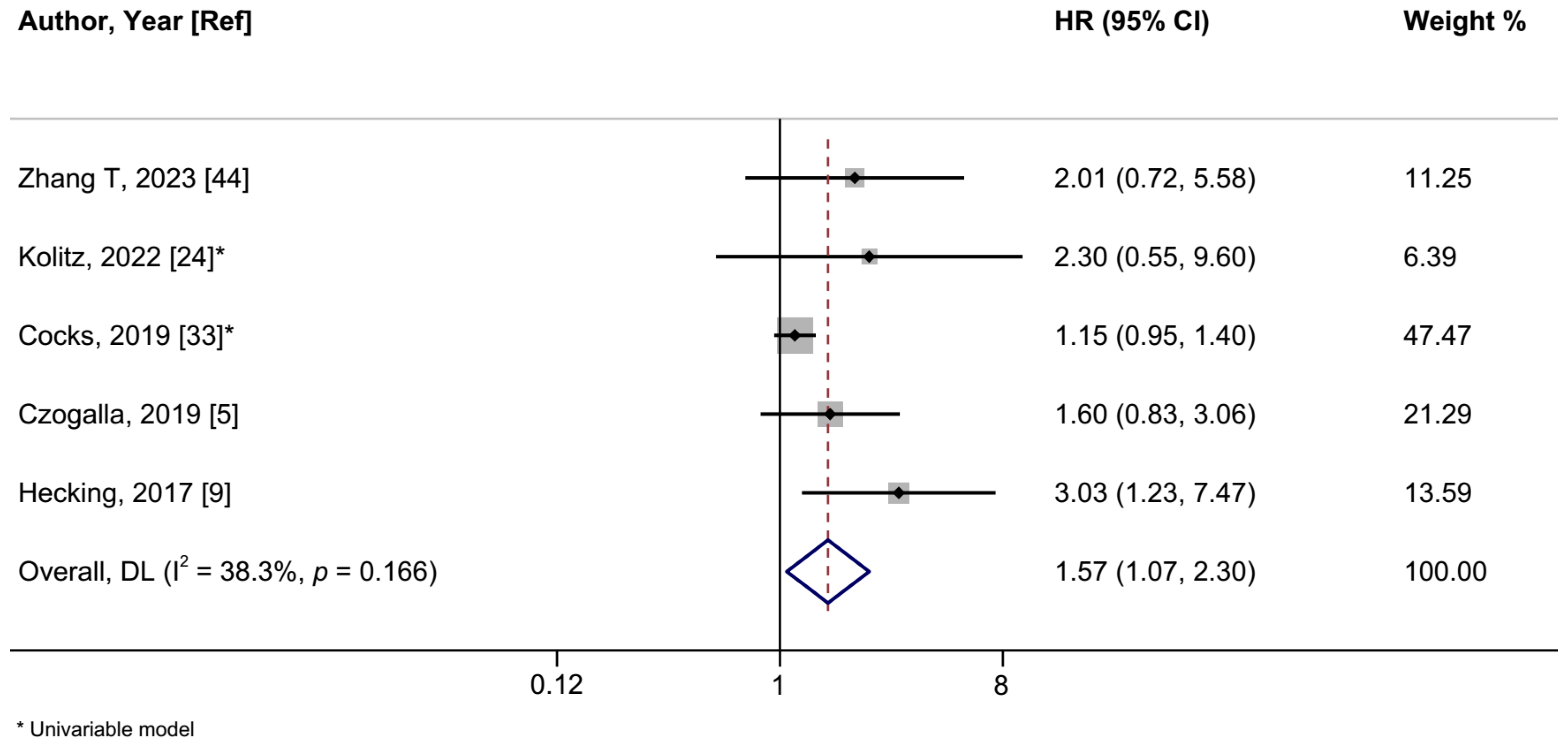
| Author, Year | Country | Mean Age (Range), Years | Sample Size | Stage | Histology and Molecular Status | Clone Antibody | Cutoff | Clinical Outcome |
|---|---|---|---|---|---|---|---|---|
| Howitt, 2016 [34] | USA | 69 (49–93) | 23 | NR | VSCC according to p16 status | 9A11 | H-score | NR |
| Hecking, 2017 [9] | Germany | 64 (26–93) | 103 | Primary, advanced, metastatic | VSCC according to p16/HPV DNA status | 22C3 | TCS ≥ 2% in TC ≥ 5% | OS, RFS |
| Koncar, 2017 [4] | USA | 61 (29–85) | 83 | Primary, advanced, metastatic | VSCC, p53 wild-type | SP142 | TC ≥ 5% | NR |
| Palisoul, 2017 [35] | USA | 65 (NR) | 51 | Primary, advanced, metastatic | VSCC (85%) and AC (15%) | 22C3 | TCS ≥ 2% in TC ≥ 5% | NR |
| Sznurkowski, 2017 [10] | Poland | 68 (36–85) | 84 | Primary, advanced | VSCC | 22C3 | TC ≥ 5% | OS |
| Choschzick, 2018 [36] | Switzerland | 69 (37–89) | 55 | Primary, advanced, metastatic | VSCC according to HPV RNA status | E1L3N | TC ≥ 1% | OS |
| Ott, 2018 [37] | Worldwide | 59 (18–87) | 18 | Metastatic | VSCC | 22C3 | CPS ≥ 1 | NR |
| Chinn, 2019 [19] | USA | NR | 20 | NR | VSCC according to p16 status | SP142 | TC ≥ 1% | NR |
| Cocks, 2019 [33] | USA | 58 (25–87) | 21 | Primary, advanced | VSCC | E1L3N | TC ≥ 1% | OS, DFS, CSS |
| Czogalla, 2019 [5] | Germany | 71 (20–96) | 128 | Primary, advanced, metastatic | VSCC | SP263 | TC ≥ 1% | OS, PFS |
| Lérias, 2019 [7] | Portugal | 74 (26–93) | 83 | Primary, advanced | VSCC according to p16/HPV DNA status | 22C3 | TC ≥ 1% | OS |
| Thangarajah, 2019 [1] | Germany | 62 (48–71) | 70 | Primary, advanced | VSCC | 28-8 | TC ≥ 1% | NR |
| Xing, 2019 [26] | USA | NA (25–79) | 20 | Primary, advanced, metastatic | VSCC according to p16/HPV RNA status | 22C3 | CPS ≥ 1 | NR |
| Curley, 2020 [38] | USA | NR | 19 | NR | VSCC HPV-associated vs. unassociated status | SP142 | CPS ≥ 1 | NR |
| Dibbern, 2020 [39] | USA | NR | 18 | NR | VSCC HPV-associated | SP142 | CPS ≥ 1 | NR |
| Steiniche, 2020 [17] | Denmark | 68 (66–73) | 44 | Advanced, metastatic | VSCC | 22C3 | CPS ≥ 1 | NR |
| Williams, 2020 [40] | USA | 62 (25–92) | 73 | Primary, advanced | VSCC | 22C3 | TC ≥ 1% | NR |
| Contos, 2021 [20] | USA | NR | 48 | NR | VSCC | SP142 | TC ≥ 5% | NR |
| Garganese, 2021 [41] | Italy | 78 (48–96) | 101 | Primary, advanced | VSCC according to p16 status | SP263 | TC ≥ 5% | NR |
| Kolitz, 2022 [24] | USA | 60 (NR) | 36 | Primary, advanced | VSCC | 22C3 | CPS ≥ 1 | OS, PFS |
| Necchi, 2022 [29] | USA | 64 (29–89) | 143 | Primary, advanced, metastatic | VSCC | 22C3 | TC ≥ 1% | NR |
| Shapira-Frommer, 2022 [42] | Worldwide | 64 (31–87) | 101 | Primary, advanced, metastatic | VSCC | 22C3 | CPS ≥ 1 | NR |
| Corey, 2023 [43] | USA | 66 (30–90) | 427 | Primary, advanced, metastatic | VSCC | SP142 | TC ≥ 1% | NR |
| Zhang T, 2023 [44] | China | 67 (29–91) | 69 | Primary, advanced | VSCC according to p16/HPV IHC status | 22C3 | CPS ≥ 1 | OS, PFS |
| Bui, 2024 [45] | USA | 70.6 (34–96) | 53 | Primary, advanced, metastatic | VSCC according to p16 status | CD274 | CPS ≥ 1 | NR |
| Gordinier, 2024 [46] | USA | 64.7 (36–93) | 21 | Primary, advanced, metastatic | VSCC | 22C3 | CPS ≥ 1 | NR |
| PD-L1 Expression in Tumor Cells | Positivity | 95%CI | I2 | Studies |
|---|---|---|---|---|
| Overall | 59.9% | 47.8% to 71.4% | 96.4% | 26 |
| By cutoff thresholds | ||||
| CPS ≥ 1 | 82.1% | 74.5% to 88.7% | 68.6% | 10 |
| TC ≥ 1% | 56.6% | 39.0% to 73.4% | 96.4% | 9 |
| TC ≥ 5% | 30.5% | 13.5% to 50.9% | 95.2% | 6 |
| H-score | 43.5% | 25.6% to 63.2% | - | 1 |
| By PD-L1 antibodies | ||||
| E1L3N | 59.4% | 29.9% to 85.5% | 82.6% | 2 |
| SP263 | 70.2% | 48.9% to 87.6% | 91.1% | 2 |
| 22C3 | 56.9% | 37.5% to 75.3% | 96.9% | 13 |
| SP142 | 64.3% | 34.6% to 89.0% | 97.0% | 6 |
| 28-8 | 32.9% | 23.0% to 44.5% | - | 1 |
| 9A11 | 43.5% | 25.6% to 63.2% | - | 1 |
| CD274 | 90.6% | 79.6% to 95.9% | - | 1 |
| By HPV positivity | ||||
| HPV-positive | 55.2% | 35.1% to 74.4% | 93.3% | 13 |
| HPV-negative | 68.7% | 48.2% to 85.9% | 94.4% | 15 |
| By cancer stage | ||||
| Primary stages | 40.1% | 24.4% to 56.8% | 90.6% | 9 |
| Advanced/metastatic stages | 42.9% | 24.5% to 62.3% | 89.6% | 13 |
| PD-L1 expression in intratumoral immune cells | Positivity | 95%CI | I2 | Studies |
| Overall | 75.6% | 52.9% to 92.5% | 95.4% | 6 |
| By cutoff thresholds | ||||
| CPS ≥ 1 | 91.9% | 75.8% to 99.6% | 78.3% | 2 |
| TC ≥ 5% | 36.9% | 27.4% to 47.6% | - | 1 |
| TC ≥ 1% | 74.2% | 46.0% to 94.4% | 93.7% | 3 |
| By PD-L1 antibodies | ||||
| CD274 | 84.9% | 73.0% to 92.3% | - | 1 |
| E1L3N | 66.7% | 45.4% to 82.8% | - | 1 |
| SP263 | 91.4% | 85.3% to 95.1% | - | 1 |
| 22C3 | 73.1% | 8.2% to 100% | 98.2% | 2 |
| 28-8 | 58.6% | 46.9% to 69.4% | - | 1 |
| PD-L1 expression in peritumoral immune cells | Positivity | 95%CI | I2 | Studies |
| Overall | 78.9% | 54.4% to 95.5% | 91% | 3 |
| PD-L1 expression and VSCC prognosis | HR | 95%CI | I2 | Studies |
| Overall survival | 1.43 | 1.06 to 1.93 | 28.9% | 7 |
| Progression-free survival | 1.57 | 1.07 to 2.30 | 38.8% | 5 |
| Cancer-specific survival | 1.12 | 0.90 to 1.40 | - | 1 |
| PD-L1 expression in intratumoral immune cells and VSCC prognosis | HR | 95%CI | I2 | Studies |
| Overall survival | 1.44 | 0.59 to 3.51 | 81.7% | 4 |
| Progression-free survival | 1.43 | 0.72 to 2.94 | 43.6% | 3 |
Disclaimer/Publisher’s Note: The statements, opinions and data contained in all publications are solely those of the individual author(s) and contributor(s) and not of MDPI and/or the editor(s). MDPI and/or the editor(s) disclaim responsibility for any injury to people or property resulting from any ideas, methods, instructions or products referred to in the content. |
© 2025 by the authors. Licensee MDPI, Basel, Switzerland. This article is an open access article distributed under the terms and conditions of the Creative Commons Attribution (CC BY) license (https://creativecommons.org/licenses/by/4.0/).
Share and Cite
Flindris, S.; Margioula-Siarkou, C.; Chalitsios, C.V.; Margioula-Siarkou, G.; Almperi, E.-A.; Almperis, A.; Styliara, E.; Flindris, K.; Paschopoulos, M.; Navrozoglou, I.; et al. Positivity Rate of PD-L1 Expression and Its Clinical Significance in Vulvar Cancer: A Systematic Review and Meta-Analysis. Int. J. Mol. Sci. 2025, 26, 4594. https://doi.org/10.3390/ijms26104594
Flindris S, Margioula-Siarkou C, Chalitsios CV, Margioula-Siarkou G, Almperi E-A, Almperis A, Styliara E, Flindris K, Paschopoulos M, Navrozoglou I, et al. Positivity Rate of PD-L1 Expression and Its Clinical Significance in Vulvar Cancer: A Systematic Review and Meta-Analysis. International Journal of Molecular Sciences. 2025; 26(10):4594. https://doi.org/10.3390/ijms26104594
Chicago/Turabian StyleFlindris, Stefanos, Crysoula Margioula-Siarkou, Christos V. Chalitsios, Georgia Margioula-Siarkou, Emmanouela-Aliki Almperi, Aristarchos Almperis, Effrosyni Styliara, Konstantinos Flindris, Minas Paschopoulos, Iordanis Navrozoglou, and et al. 2025. "Positivity Rate of PD-L1 Expression and Its Clinical Significance in Vulvar Cancer: A Systematic Review and Meta-Analysis" International Journal of Molecular Sciences 26, no. 10: 4594. https://doi.org/10.3390/ijms26104594
APA StyleFlindris, S., Margioula-Siarkou, C., Chalitsios, C. V., Margioula-Siarkou, G., Almperi, E.-A., Almperis, A., Styliara, E., Flindris, K., Paschopoulos, M., Navrozoglou, I., Tsilidis, K. K., Dinas, K., Petousis, S., & Markozannes, G. (2025). Positivity Rate of PD-L1 Expression and Its Clinical Significance in Vulvar Cancer: A Systematic Review and Meta-Analysis. International Journal of Molecular Sciences, 26(10), 4594. https://doi.org/10.3390/ijms26104594






